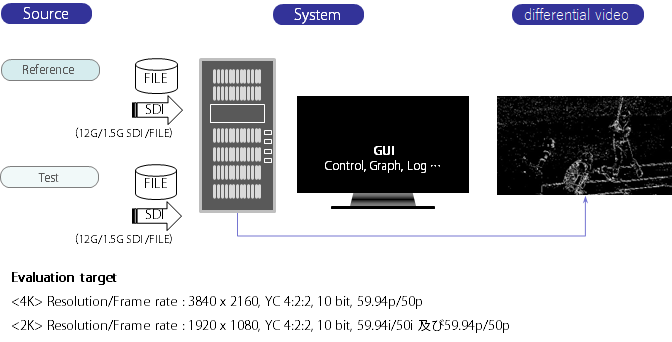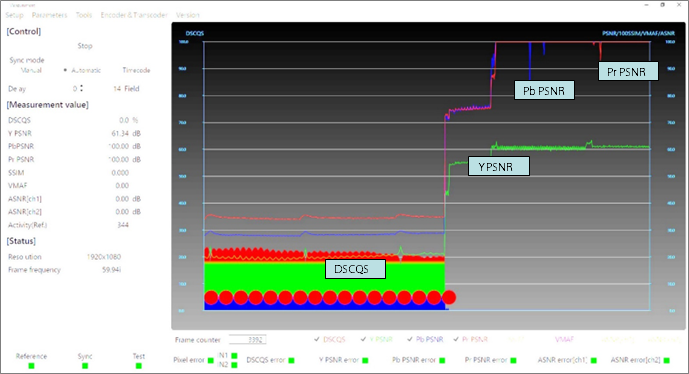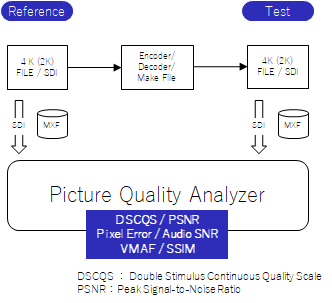
The Picture Quality Analyzer series now supports evaluation of files.
The Picture Quality Analyzer series now supports evaluation of files including MXF. The expansion of this interface greatly expands the scope of application of picture quality analysis. Until now, FR (Full Reference) type PQA has been used to measure baseband signals by SDI, but this time, the measurement target has been expanded to files such as MXF format. This makes it possible to use MXF files as test signals for FR PQA against SDI reference signals.
By correcting the time axis of 2160 59.94p full sample 4K reference video and test video signals and synchronizing the pixels perfectly, it is possible to measure luminance difference value Y_PSNR and color difference difference Pb/Pr PSNR.
In addition to PSNR, DSCQS (Double Stimulus Continuous Quality Scale) based on the ITU-T J.144 international standard is measured in every frame. Its evaluation accuracy is equivalent to subjective evaluation by ITU-R BT500. This PQA is ideal for evaluating encoders with systems that combine basebands and files, evaluation of filing equipment, and evaluation of transcoders. Pixel error, Audio SNR, VMAF, and SSIM can also be measured.
Usage
- SDI and FILE mixed 4K/2K Picture quality measurement of broadcasting equipment such as codec systems and broadcasting systems
- 4K/2K Picture quality measurement of filing systems and transcoder systems
System overview

Easy-to-understand display of measurement results on PC GUI
Since DSCQS, the objective quality score obtained from VP10000 is usable as a subjective score in its own given by a human eyes (QoE: Quality of Experience), whether or not user quality requirement is met can precisely be judged on a frame basis. In general, at a broadcasting station, for instance, degree of picture quality degradation not exceeding 12 % (4.5 or more in 5-point scale) is acceptable from the viewpoint of service. DSCQS : Double Stimulus Continuous Quality Scale.

Input file format
It supports the following input file.
| 2K compatible formats | 【Main supported standard】 XDCAM(MPEG HD422 [50Mbps]) 【Other supported file formats】 《File format》 MP4, TS, PS, F4V, MXF, MOV 《Video codec》 MPEG1/2/4, H.264, H.265, MJPG, DNxHD (36/120/145/185/185x/220/220x), ProRes 422 (Proxy/LT/Standard/HQ) 《Audio codec》 PCM, MPEG-1 Layer2(MP2), MPEG-2 AAC-LC, MPEG-4 AAC-LC |
| 4K compatible formats | 【Main supported standard】 XAVC(QFHD Long422 200 [200Mbps]) / XAVC(QFHD Intra Class300 [600Mbps]) 【Other supported file formats】 《File format》 MP4, TS, F4V, MXF, MOV 《Video codec》 DNxHR (LB/SQ/HQ/HQX), ProRes 422 (Proxy/LT/Standard/HQ), H.264, H.265 《Audio codec》 PCM, MPEG-1 Layer2(MP2), MPEG-2 AAC-LC, MPEG-4 AAC-LC |
SDI input
t supports the following input signals
| Video signal <Standard> | 12GSDI or HD-SDI two BNC inputs |
| Video signal <Frame rate/Resolution> | 4K:3840 × 2160 YC 4:2:2, 10bit, 59.94p/50p (12G-SDI) 2K:1920 ×1080 59.94i/50i SMPTE292M/274M |
Main measurement specifications
| Output | Video signal | Reference video/Test video/Difference video monitor output and OSD of measurement results & frame/field delay |
| Measurement | Video/Audio | ・Reference signal:SDI Test signal:SDI/FILE PSNR Y/C, DSCQS, Pixel error, Audio SNR (Real time standard measurements) ・Reference signal:FILE Test signal:FILE PSNR Y/C, DSCQS, Pixel error, Audio SNR (Non real time) VMAF, SSIM (Non real time, On/Off switchable) |
| Delay compensation | Auto/Manual synchronization | 1080i[HD] -1 sec ~ 30 sec(1800 field) 2160p[4K] -1 sec ~ 12 sec(720 frame) |

